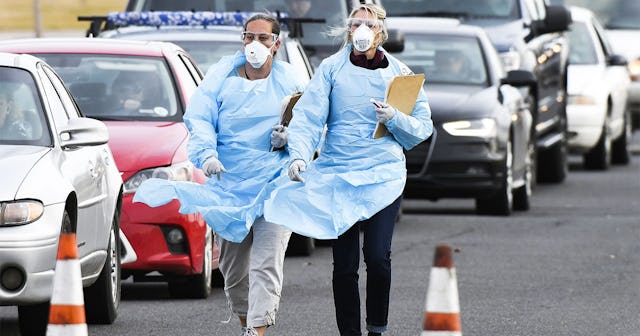NYC Microbiologist Tells Us More About When The Apex May Hit

Ever since the World Health Organization (WHO) declared COVID-19 a global pandemic, the world has been thrown into a collective state of uncertainty. For the first time, the entire world is facing the same enemy and asking the same questions: how can we go back to normal while keeping our populations safe? When can we go back to normal? Will we go back to normal?
And the truth is nobody knows the answer for certain. The experts have models and estimates. The officials have projections and hopes. But an actual answer is currently out of reach.
We know one thing: we need to flatten the curve, so the healthcare system isn’t overwhelmed when the outbreak reaches its apex—the point in time when we have the highest number of cases. After the apex, the confirmed number of cases should begin to decrease.
Different regions will likely hit the apex at different points in time, depending on when the virus spread in the community and how quickly social distancing measures were enacted and followed. New York Governor Andrew Cuomo has suggested that the apex in New York, the epicenter of the outbreak in the United States, will likely come this week or next.
Scary Mommy interviewed microbiologist Dr. Dean Hart, who agrees with Governor Cuomo’s determination. The apex will likely hit New York this week, but he stresses that the apex refers to hospital burden—meaning, the apex is the point during which the burden on hospitals will be greatest, not when the most citizens are exposed. Because in his estimation, a significant portion of the population has already been exposed to the virus and likely suffered mild symptoms or no symptoms while the person’s own immune system destroyed the virus.
U.S. Navy/Getty
As that burden on hospitals is lessened, the conversation about returning to some modified version of normal can begin. He sees a potential path toward reinvigorating society in a modified manner while keeping the population safe arriving in a matter of weeks, rather than months—as long as key factors are met. Namely, enough personal protection equipment (PPE) for all healthcare workers and the general public, and testing. Testing everybody. Maybe even multiple times.
Testing the entire population would allow the population to divide into three distinct groups: those who had the virus (asymptomatically or not) and now have antibodies that offer a measure of immunity, those who never had the virus (who will then either choose to wear PPE in public or stay home), and those who are actively shedding virus (whether because they are pre-symptomatic, symptomatic, or asymptomatic).
The first group would be free to return to some level of normal activity. Though officials have been reluctant to say for sure whether those who have recovered from COVID-19 are now immune, Dr. Hart suggests looking at the principles of virology. He believes there will be immunity in patients who have recovered, for at least a period of time, and re-infection likely will not recur soon unless the person is exposed to a huge viral load.
The second group, those who have never had the virus, will be faced with a choice. Each person will have to weigh their own comfort level—and almost definitely only return to society with utmost precautions, including a mask and gloves.
John Moore/Getty
The third group of people, those actively shedding the virus, will stay home until a point in time when they are no longer shedding virus.
PPE has been scarce. Testing has been limited. The two factors that most need to be met are the two factors that have been most limited. To have enough PPE and testing on the scale, Dr. Hart suggests, would mean industry ramps up production. But he believes industries are already firing up to meet the demand in the market, and within months testing and PPE with both be readily available.
Dr. Hart stresses the importance of bioethics, and the government’s dual role of protecting citizens’ health while also protecting their livelihoods. This means finding a path toward normalcy while also ensuring there’s no undue risk on the population.
The truth is that the virus will be with us for a while, likely until a vaccine is found, which — even in the most hopeful of scenarios — will not happen until 2021. The truth is that the normal we all crave might not return on the other side of the apex; a large part of the population may still be quarantined. But maybe there’s a light at the end of this dark tunnel we’re all in together.
Information about COVID-19 is rapidly changing, and Scary Mommy is committed to providing the most recent data in our coverage. With news being updated so frequently, some of the information in this story may have changed after publication. For this reason, we are encouraging readers to use online resources from local public health departments, the Centers for Disease Control, and the World Health Organization to remain as informed as possible.
This article was originally published on